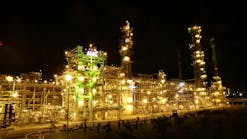Chinas gas industry is easily the worlds oldest.
The Chinese produced gas in the Sichuan basin as early as the 3rd century B.C., when it was piped through bamboo trunks and used for salt refining and cooking.
Thats the finding of Wood Mackenzie Consultants Ltd., Edinburgh, which says despite Chinas industrial progress, gas has never lived up to its promising start. It remains a poor relation of oil and coal. The latter is Chinas most plentiful hydrocarbon fuel.
Elf Aquitaine SA also is aware that gas is Chinas sleeping tiger. In a report produced by the company outlining its Asian ambitions, Joel Bouchaud, Elf vice-president for exploration and production in the East, former Soviet Union, and Latin America, said, Much of the exploration potential in Asia lies in gas. It is thought, for example, that China could become a (significant) gas producing country, after having been a big coal producer.
Gas lure
Wood Mackenzie says although Chinas gas demand and production are set to grow rapidly during the next decade, the share of gas in the countrys total energy picture will still be small in comparison with coal and oil.
The analyst predicts gas demand in China will rise to 5.7 bcfd by 2010, three times todays volume. The main driver will be electrical power generation, although increasing urbanization will play a part.
China has estimated gas reserves of 35 tcf, of which 40% are in the Sichuan basin. In 1994, Chinas gas production amounted to 1.6 bcfd. Production is expected to reach 2.6 bcfd by 2000 and 4.1 bcfd by 2010.
Even though Elf admits to little success in Asian projects in the past, prospects in China are luring the company back to the region. Elf opened offices in China last year to facilitate projects in a number of sectors.
Bouchaud said, We decided to create a representative office for exploration and production in Beijing, headed by a top grade explorer whose job is to establish contacts with the authorities, national companies, and competitors already established in China.
For us, it is a question of acquiring the necessary information that will open new prospects for onshore and offshore exploration in China to be ready, should we so decide, to return as an operator.
LPG project
With a view to an anticipated shortfall in gas production and urbanization particularly of coastal areas, Elfs Antargaz unit intends to import liquefied petroleum gas into China.
Antargaz is at an advanced stage of negotiations to start construction of an LPG import terminal in China with capacity to handle 2-3 million metric tons/year for the first few years. Of course, Elf is not relying on gas alone to secure its share of the Chinese economic boom. It also is taking the well worn path of using lubricants as a tool to establish a market presence.
Bouchaud said a very long term view is needed for China. Besides E&P, LPG, and lubricants plans, Elf is looking to gain a foothold in China for chemicals, while its Sanofi pharmaceuticals division is pursuing healthcare opportunities. The company says more than half its 52 Asian prospects are based in China.
Copyright 1996 Oil & Gas Journal. All Rights Reserved.


